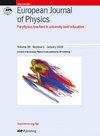“文明”在均匀各向同性宇宙中的渗透
IF 0.8
4区 教育学
Q4 EDUCATION, SCIENTIFIC DISCIPLINES
引用次数: 0
摘要
在这项工作中,我们考虑了一个理想的均匀各向同性宇宙中“文明”的传播,在这个宇宙中,所有感兴趣的行星都是宜居的。遵循超越普通本科计算物理教科书中通常的渗透思想的框架,我们研究了殖民行星数量随时间的行为,以及三种类型宇宙的总殖民时间。这些宇宙包括静态宇宙、暗能量主导宇宙和物质主导宇宙。对于所有这些类型的宇宙,我们发现随着时间的推移,殖民行星的数量与逻辑增长函数非常吻合。尽管在物质和暗能量主导的宇宙中,空间本身是在膨胀的。对于总定殖时间T,暗能量主导的宇宙的情况,其特征是发散度超出了以哈勃参数H的小值为特征的线性范围。由于哈勃球的收缩,并非宇宙中球形部分的所有行星都可以被“殖民”。换句话说,其他行星的衰退速度超过光速,使它们不可能到达。另一方面,对于一个物质主导的宇宙来说,虽然有一个明显的视界,但哈勃球是在变大而不是缩小。这导致了一个有限的总殖民时间,这取决于描述宇宙的哈勃参数;特别是,我们发现小H为T ~ H,大H为T ~ h2。本文章由计算机程序翻译,如有差异,请以英文原文为准。
Percolation of 'Civilisation' in a Homogeneous Isotropic Universe
Abstract In this work, we consider the spread of a ‘civilisation’ in an idealised homogeneous isotropic universe where all the planets of interest are habitable. Following a framework that goes beyond the usual idea of percolation in common undergraduate computational physics textbooks, we investigate the behaviour of the number of colonised planets with time, and the total colonisation time for three types of universes. These include static, dark energy-dominated, and matter-dominated universes. For all these types of universes, we find a remarkable fit with the Logistic Growth Function for the number of colonised planets with time. This is in spite of the fact that for the matter- and dark-energy dominated universes, the space itself is expanding. For the total colonisation time, T , the case for a dark energy-dominated universe is marked with divergence beyond the linear regime characterised by small values of the Hubble parameter, H . Not all planets in a spherical section of this universe can be ‘colonised’ due to the presence of a shrinking Hubble sphere. In other words, the recession speeds of other planets go beyond the speed of light making them impossible to reach. On the other hand, for a matter-dominated universe, while there is an apparent horizon, the Hubble sphere is growing instead of shrinking. This leads to a finite total colonisation time that depends on the Hubble parameter characterising the Universe; in particular, we find T ∼ H for small H and T ∼ H 2 for large H .
求助全文
通过发布文献求助,成功后即可免费获取论文全文。
去求助
来源期刊

European Journal of Physics
物理-物理:综合
CiteScore
1.70
自引率
28.60%
发文量
128
审稿时长
3-8 weeks
期刊介绍:
European Journal of Physics is a journal of the European Physical Society and its primary mission is to assist in maintaining and improving the standard of taught physics in universities and other institutes of higher education.
Authors submitting articles must indicate the usefulness of their material to physics education and make clear the level of readership (undergraduate or graduate) for which the article is intended. Submissions that omit this information or which, in the publisher''s opinion, do not contribute to the above mission will not be considered for publication.
To this end, we welcome articles that provide original insights and aim to enhance learning in one or more areas of physics. They should normally include at least one of the following:
Explanations of how contemporary research can inform the understanding of physics at university level: for example, a survey of a research field at a level accessible to students, explaining how it illustrates some general principles.
Original insights into the derivation of results. These should be of some general interest, consisting of more than corrections to textbooks.
Descriptions of novel laboratory exercises illustrating new techniques of general interest. Those based on relatively inexpensive equipment are especially welcome.
Articles of a scholarly or reflective nature that are aimed to be of interest to, and at a level appropriate for, physics students or recent graduates.
Descriptions of successful and original student projects, experimental, theoretical or computational.
Discussions of the history, philosophy and epistemology of physics, at a level accessible to physics students and teachers.
Reports of new developments in physics curricula and the techniques for teaching physics.
Physics Education Research reports: articles that provide original experimental and/or theoretical research contributions that directly relate to the teaching and learning of university-level physics.
 求助内容:
求助内容: 应助结果提醒方式:
应助结果提醒方式:


